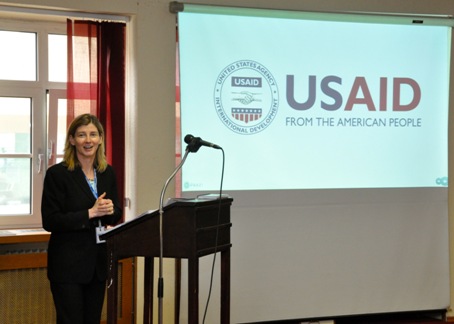You are here
Building Resilience in African Nations is Paramount to Development
Primary tabs
Building Resilience in African Nations is Paramount to Development
Mon, 2012-04-09 15:46 — Kathy Gilbeaux
STUTTGART, Germany - Nancy Lindborg, assistant administrator for USAID's Bureau of Democracy, Conflict, and Humanitarian Assistance (DCHA), addresses staff of U.S. Africa Command, March 30, 2012, as part of the Command Speaker Series. Lindborg talked about USAID's efforts in Africa and discussed how U.S. AFRICOM can better work with the interagency organization to achieve common objectives. (U.S. AFRICOM photo by Danielle Skinner)
submitted by Samuel Bendett
U.S. AFRICOM Public Affairs - by Danielle Skinner
STUTTGART, Germany, Apr 3, 2012 — In developing countries experiencing chronic crises, such as those in the Horn of Africa, disaster risk reduction is often just as important, if not more so, than humanitarian response and recovery, according to a senior official from U.S. Agency for International Development (USAID).
Nancy Lindborg, assistant administrator for USAID's Bureau of Democracy, Conflict, and Humanitarian Assistance (DCHA), addressed staff of U.S. Africa Command, March 30, 2012, to promote awareness of USAID's efforts in Africa and discuss how U.S. AFRICOM can better work with the interagency organization to achieve common objectives.
Lindborg said that one of the DCHA's goals is to build resilience among African nations so that they are better able to handle conflicts, crises, and natural disasters when they occur. This means doing things differently from how they have been done in the past with an increased focus on the prevention side. Democracy is fundamental to development, she added, because a strong legitimate government helps a country to withstand the shocks brought on by natural disasters and other crises.
"We know that droughts will happen, that earthquakes will happen, that crises will happen, and the goal is to create the kind of resilience that enables communities, nations, and regions to move through these shocks without falling back on their development gains," she said.
As a recent example, famine was declared in July 2011 in the Horn of Africa, a situation which was further complicated by conflict and turbulence in Somalia, leading to a refugee crisis in the region. USAID's early warning system predicted the upcoming famine in the Horn of Africa, and was able to begin prepositioning food in October 2010. At the time of the declaration of the famine, approximately 750,000 people were considered to be at risk of imminent death by starvation if humanitarian assistance did not reach them. According to Lindborg, USAID's approach was comprehensive, focusing not only on food distribution, but also vaccine programs, water sanitation, working with health clinics, and giving people access to vouchers to use at local markets.
USAID also launched the Forward Campaign, incorporating public service announcements, social media, and information packets, to engage the American public and encourage them to donate. The famine designation was lifted in January, but the situation in the Horn of Africa remains fragile.
"We need to bridge together our relief and development, we need to coordinate with our donor partners, and we need to do so in support of African-led frameworks," Lindborg stated, adding that military involvement is also a key part of enabling development, particularly in the area of food security.
Food security is one of USAID's seven core areas and also part of the U.S. Presidential Initiative, "Feed the Future," a $3.5 billion pledge to work with partner countries, development partners, and other stakeholders to tackle global food security challenges.
AFRICOM's Commander, General Carter Ham, discussed the link between food security and overall stability at a recent conference at the National Defense University, stressing the importance of a whole-of-government approach.
"Supporting humanitarian assistance and food security are good examples of areas in which our interagency staff bring invaluable expertise to help ensure that our efforts complement those of other U.S. government agencies," Ham said. "Because food emergencies are complex humanitarian crises, often rooted in poverty or tied to climate change or even to political issues with both short- and long-term impacts, the U.S. military offers just one facet of U.S. support to humanitarian efforts in the Horn of Africa."
USAID is one of 13 interagency organizations that U.S. AFRICOM works with to ensure its plans and activities complement those of other government programs and fit within the context of U.S. foreign policy. Through its whole-of-government approach, AFRICOM aims to draw together diplomacy, development, and defense--known as the 3Ds.
Lindborg identified disaster risk reduction as an area where USAID and the U.S. military can and should be working together.
"You cannot have fruitful development without security," she said. "The focus that you're making here on partnering for security sector developments as a means for enabling development, that is so key."
Acknowledging the differences in techniques and capabilities between the military and interagency, Lindborg said, "It is is critical to have jointness of goals and objectives but there will be times and places where you want to have differentiation on the ground to enable and leverage the uniqueness of our particular tools and capabilities."
"I think we can find ways to work more closely together for a development objective, which I know for this command has been a significant priority," she concluded.
The presentation was part of the Command Speaker Series, an initiative that brings experts on African-related topics to the AFRICOM headquarters in Stuttgart, Germany to share diverse perspectives.

Recent Comments